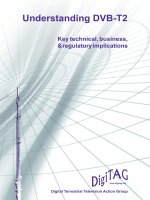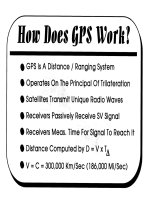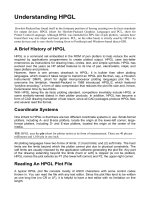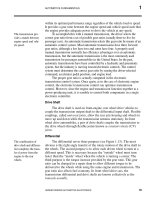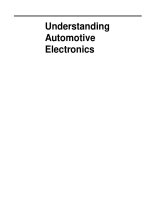Understanding DVB-T2
Bạn đang xem bản rút gọn của tài liệu. Xem và tải ngay bản đầy đủ của tài liệu tại đây (978.85 KB, 25 trang )
Digital Terrestrial Television Action Group
Key technical, business,
& regulatory implications
Understanding DVB-T2
www.digitag.org
0
Published by
DigiTAG - The Digital Terrestrial Television Action Group
L’ Ancienne-Route 17A
CH-1218 Grand-Saconnex
Geneva, Switzerland
Tel: +41 22 717 2735
Fax: +41 22 747 4735
www.digitag.org
© copyright 2009 DigiTAG
All rights reserved
Version 1.0
1
Understanding DVB-T2
Key technical, business, and regulatory
implications
Table of Contents
Introduction ...................................................................................................................... 2
The need for a new terrestrial television standard ...................................................... 3
Limited frequency availability .................................................................................... 3
Digital switchover ....................................................................................................... 4
DVB-T2 for terrestrial broadcasting ............................................................................ 4
Technical overview of the DVB-T2 specification ......................................................... 5
Key technical features ................................................................................................. 5
Physical layer features ........................................................................................... 5
Network configuration ............................................................................................ 6
Optimised performance to match frequency channel propagation
characteristics ........................................................................................................ 6
Expected spectrum efficiency gain .............................................................................. 7
Status (pilots, announced launches) ............................................................................. 7
Key DVB-T2 market players ......................................................................................... 9
Broadcasters ................................................................................................................ 9
Broadcast network operators ....................................................................................... 9
Manufacturers ............................................................................................................ 10
Viewers ...................................................................................................................... 10
DVB-T2 business issues ............................................................................................... 12
The demand for the DVB-T2 standard ...................................................................... 12
Free-to-air services .............................................................................................. 13
Pay-DTT services ................................................................................................. 13
Broadcaster’s business case ....................................................................................... 13
Approaches to launching DVB-T2 ............................................................................ 14
Markets having completed digital switchover ...................................................... 14
Greenfield markets ............................................................................................... 14
Markets undertaking digital switchover ............................................................... 14
Strategies for marketing DVB-T2 ............................................................................. 15
Possible migration from DVB-T towards DVB-T2? ................................................. 15
Pan-European industry recommendations ................................................................. 16
DVB-T2 regulatory issues ............................................................................................ 17
International Telecommunications Union (ITU) Agreements ................................... 17
European Union activities ......................................................................................... 18
Conclusion ..................................................................................................................... 20
Annex 1.......................................................................................................................... 21
Status of broadcast services on the terrestrial platform in Europe ............................. 21
2
Introduction
The DVB-T standard is the most successful digital terrestrial television standards in
the world. First published in 1995, it has been adopted by more than half of all
countries in the world. Since the publication of the DVB-T standard, however,
research in transmission technology has continued, and new options for modulating
and error-protecting broadcast steams have been developed. Simultaneously, the
demand for broadcasting frequency spectrum has increased as has the pressure to
release broadcast spectrum for non-broadcast applications, making it is ever more
necessary to maximise spectrum efficiency.
In response, the DVB Project has developed the second-generation digital terrestrial
television (DVB-T2) standard. The specification, first published by the DVB Project
in June 2008, has been standardised by European Telecommunication
Standardisations Institute (ETSI) since September 2009. Implementation and
product development using this new standard has already begun.
The possibility to increase the capacity in a digital terrestrial television (DTT)
multiplex is one of the key benefits of the DVB-T2 standard. In comparison with the
current digital terrestrial television standard, DVB-T, the second-generation
standard, DVB-T2, provides a minimum increase in capacity of at least 30% in
equivalent reception conditions using existing receiving antennas. Some preliminary
testing, however, suggests that the increase in capacity obtained in practice may be
closer to 50%. This can make possible the launch of new broadcast services that
make intensive use of frequency capacity.
However, the implementation of a new digital terrestrial television (DTT) standard
will have a profound impact upon the broadcast industry. The cost of developing,
distributing, and implementing new equipment will need to be borne by
manufacturers, network operators, and viewers. Business issues related to financing
the launch of services the DVB-T2 standard need to be explored. The demand for
services using DVB-T2 will likely vary depending on the demands of the market as
will the approach for launching such services. Broadcasters will also need to
consider possible business cases and how current revenue streams can be maintained
and/or augmented.
Two excellent documents, the DVB-T2 specification (ETSI EN302755) and the
Implementation Guidelines (DVB Bluebook A133), are available with the details of
the technology. However, this handbook seeks to provide a wider understanding of
the DVB-T2 standard to encompass issues beyond the technology. It addresses the
key technical, business, and regulatory issues that must be taken into consideration
by the broadcast industry when contemplating a launch of services using the DVB-
T2 standard.
3
The need for a new terrestrial television
standard
The terrestrial television platform remains one of the most important television
delivery platforms in Europe. It is currently one of the most widespread broadcast
transmission systems and provides viewers with nearly universal access to both free-
to-air and pay television services.
The conversion of the terrestrial platform from analogue to digital technology has
enabled increased competition in the television market. In many European markets,
viewers have been able to access many new services, including greater television
programme choice, enhanced quality, and interactivity. The launch of pay services
on the DTT platform has allowed viewers to benefit from such services as pay-per-
view events, near video-on-demand, and basic pay bouquets. The unique features of
the DTT platform allow viewers to benefit from regional and local services as well
as portable and mobile reception.
Viewers have demonstrated strong confidence in the DTT platform given the high
penetration of services. Currently, the DTT platform is the fastest growing digital
platform in Europe and in some countries the number of viewers relying on the
terrestrial television platform for their primary television services has increased
significantly since the launch of digital services. Given the demand of viewers to
access television services on the terrestrial television platform, broadcasters will
want to maximize the DTT services available.
Limited frequency availability
The terrestrial television platform has traditionally used frequencies in Bands III
(174-230 MHz) and IV/V (470-862 MHz) for the provision of broadcast television
services. The frequency spectrum in Bands III and IV/V are particularly
advantageous for certain types of services since they provide a good balance
between coverage area for a certain transmitter power, including some lower power
applications, and separation distance between transmitters.
These frequencies have traditionally been reserved exclusively for broadcasters.
However, the demand for access to these frequency bands has been strong from
other service providers including telecom operators and technology firms.
The propagation characteristics of the frequencies in Bands IV/V are proving to be
particularly appealing to telecom operators for the provision of mobile broadband
services which they believe will include 75% of all Internet subscribers by 2013.
Because it can be expensive to provide broadband service through a fixed telephone
line in rural areas, telecom operators have called for the launch of mobile broadband
services in these areas as a way to reduce the digital divide existing in parts of
Europe. Currently, several national administrations in Europe have decided to
allocate 72 MHz in Band V, in the frequency range from 790–862 MHz, for the
provision of mobile telecom (IMT) services.
Other applications can also make use of the frequencies in Bands IV/V. Leading
information technology firms such as Microsoft and Intel have called for the use of
wireless broadband services and other such applications in the so-called “white
spaces” where frequencies at a given location and at a given time are available for
use. In the United States, the Federal Communications Commission (FCC) has given
its approval for the use of white spaces by unlicensed devices in
the frequencies
Section
1
4
reserved for broadcast services. However, the approval of such devices has not yet
begun.
Other applications, such as WiMAX which provides wireless broadband access
based in a local area, could also benefit from the frequencies in Bands IV/V.
However, this would require frequency allocation from national administrations as
well as changes to the ITU’s Radio Regulations.
In Europe, the frequencies in Bands IV/V have been used for the provision of
services ancillary to broadcasting (SAB/SAP), which includes such equipment as
wireless microphones, and used extensively in the production of audiovisual content
as well as in theatre, music and sporting events. These frequencies are also, in some
cases, reserved for emergency communication services, also known as public
protection and disaster relief (PPDR).
Digital switchover
The move from analogue to digital television on the terrestrial platform has enabled
countries to release broadcast frequencies for new services. The number of
frequency channels available as well as the date of their availability will vary
between countries. In Europe, the European Commission has recommended that its
Member-States complete the process by 2012. While this deadline will be achieved
by some, it may not be possible for all Member-States. Further information on the
status of analogue switch-off in Europe can be found in Annex 1.
At the forefront of digital switchover, broadcasters in many countries have made use
of frequencies available in Bands IV/V for the launch of DTT services. Viewers
have been able to access new television programme services as an incentive to
convert from analogue to digital technology. In many cases, it has been necessary to
switch-off existing analogue terrestrial television services in order to provide
sufficient capacity for the launch of nationwide DTT services or to extend the
coverage of DTT services to ensure universal coverage.
The debate on how best to re-allocate frequencies in Bands IV/V that had previously
been used for analogue broadcast services has been fierce in Europe given the
demands of broadcasters, telecom operators, and other (potential) users.
DVB-T2 for terrestrial broadcasting
To meet with the demands of television viewers, broadcasters must be prepared to
launch new services on the DTT platform. Depending on the needs of a given
market, such services as video-on-demand, HDTV, and mobile television must be
made available to ensure the appeal and competitiveness of the DTT platform. In
addition, broadcasters will want to retain sufficient flexibility to ensure that the DTT
platform can evolve and provide new services as they become available. However,
the provision of any additional services will require the allocation of additional
frequencies in Bands IV/V for broadcast services.
The development of the DVB-T2 specification demonstrates the broadcast industry’s
confidence in the terrestrial television platform. Constrained by limited frequency
capacity, the terrestrial television platform needed a new, more efficient,
transmission system to meet the demands of the future and to allow for the launch of
new services. The DVB Project responded in June 2008 with the publication of the
DVB-T2 specification.
5
Technical overview of DVB-T2
As a first step in developing the DVB-T2 specification, the DVB Project developed
the key commercial requirements for the proposed specification. These commercial
requirements placed some limitations on the technology that could be used but also
ensured that the new specification could meet with the needs of the existing
broadcast market.
Among the 21 commercial requirements approved by the DVB Project, it was
necessary that the new specification could make use of existing domestic receiving
antennas and transmitter infrastructure, provide a minimum of 30% capacity
increase compared with the DVB-T standard in similar reception conditions, and
meet with the interference levels and spectrum mask requirements of the Geneva
2006 Agreement. The specification is also designed to target fixed rooftop antennas.
Based on these commercial requirements, the DVB Project established a group to
develop the technical features of the proposed specification.
Key technical features
Building on the success of DVB-T, the DVB-T2 specification incorporates the latest
developments in modulation and error-protection to increase the bit-rate capacity
and improve signal robustness. To achieve these improvements, detailed changes
have been made to the physical layer features, to the network configuration, and to
optimize performance to match the propagation characteristics of the frequency
channel.
The DVB-T2 commercial requirements called for capacity increase of 30%
compared with DVB-T in equivalent reception conditions. However, current field
testing suggests that the capacity gain may be closer to 65%. However, it is not until
widespread experience is gained with DVB-T2 in all application circumstances that
the full extent of its beneficial gain will be known.
Physical layer features
Like the DVB-T standard, the DVB-T2 specification uses OFDM (Orthogonal
Frequency Division Multiplex) modulation. The availability of a large number of
modes allows for the same level of flexibility to suit the specific area of application
as with the DVB-T standard. However, the addition of the 256 QAM mode in the
DVB-T2 specification allows for the ability to increase the number of bits carried
per data cell and benefit from improved FEC (forward error correction) which gives
a major capacity boost.
Like the DVB-S2 standard, the DVB-T2 specification makes use of LDPC (Low-
density parity-check) codes in combination with BCH (Bose-Chaudhuri-
Hocquengham) to protect against high noise levels and interference. In comparison,
the DVB-T standard, which makes use of convolutional coding and Reed-Solomon,
two further code rates have been added.
As with the DVB-T standard, the DVB-T2 specification makes use of scattered pilot
patterns for use by receivers to compensate for changes in channels as a result of
time and frequency. The DVB-T2 specification has the additional flexibility
provided by the choice of eight scattered pilot patterns that can be selected based
upon the FFT size and Guard Interval fraction adopted to maximize the data
payload.
Section
2
6
The DVB-T2 specification offers a choice of various robustness and protection
levels for each service separately within a transport stream carried by a signal in a
given channel. This allows each service to have a unique modulation mode
depending on the required signal robustness through the use of Physical Layer Pipes
(PLP).
Network configuration
The DVB-T2 specification allows for the possibility of maximizing the performance
in single frequency network applications. Compared with the DVB-T standard, new
carrier modes have been added to improve the performance of SFNs and increase the
symbol period.
This increase in the symbol period, in turn, allows for a reduction in the proportional
size of the guard interval while still handling multipath reflections. An additional
Alamouti coding mode is also available in option for simple SFNs where a receiver
can benefit from signals simultaneously received from more than one transmitter.
Using these features, it has been estimated that the use of a SFNs could allow for a
potential capacity gain of up to 67% compared with a DVB-T mode of similar
robustness.
Compared with the DVB-T standard, the DVB-T2 specification allows for a
reduction in the peak to average power used in the transmitter station. The peak
amplifier power rating can be reduced by 25% which can significantly reduce the
total amount of power that must be made available for the functionality of high
power transmission stations. This is achieved through the use of tone reservation and
ACE (active constellation extension) techniques.
The DVB-T2 specification defines a single profile which incorporates time-slicing
but not time-frequency-slicing (TFS). Features which would allow a possible future
implementation of TFS (for receivers with two tuners/front-ends) can be found in
annex E (ETSI EN302755). TFS might in future make it possible for a large
multiplex of signals to be spread across several linked frequencies and thus benefit
from a potentially significant gain in capacity as a result of statistical multiplexing
and a gain in network planning as a result of increased frequency diversity.
Preliminary analysis within DVB suggests that TFS may allow a capacity gain of
approximately 20% and a network planning gain of 3-4 dBs.
Comparison of available modes in DVB-T and DVB-T2
DVB-T DVB-T2
FEC
Convolutional Coding + Reed
Solomon 1/2, 2/3, 3/4, 5/6, 7/8
LPDC + BCH 1/2, 3/5, 2/3,
3/4, 4/5, 5/6
Modes QPSK, 16QAM, 64QAM
QPSK, 16QAM, 64QAM,
256QAM
Guard Interval 1/4, 1/8, 1/16, 1/32
1/4, 19/256, 1/8, 19/128, 1/16,
1/32, 1/128
FFT size 2k, 8k 1k, 2k, 4k, 8k, 16k, 32k
Scattered Pilots 8% of total 1%, 2%, 4%, 8% of total
Continual Pilots 2.6% of total 0.35% of total
Source: DVB Project
Optimised performance to match frequency channel propagation characteristics
The DVB-T2 specification provides for improved signal robustness against external
influences such as the impact cause by geography, weather, and buildings. This is
7
achieved through the use of the rotated constellations technique and time and
frequency interleaving.
Rotated constellations provide significantly improved robustness against loss of data
cells by ensuring that loss of information from one channel component can be
recovered in another channel component. This is achieved by mapping data on
normal QAM (x,y axis) which is then rotated in the “I-Q” plane so that each axis on
its own (u1, u2) carries sufficient information. The I and Q components are sent at
different times using different cells to ensure information recovery if necessary.
Time interleaving provides further signal robustness against disturbances such as
impulsive noise over a given period of time and disturbances over a limited
frequency span.
Expected spectrum efficiency gain
The exact capacity gain that can be achieved using the DVB-T2 specification in
comparison with the DVB-T standard is not yet fully known. Commercial
requirements called for a capacity gain of 30% in comparison with DVB-T in
equivalent reception conditions. However, the current transmission mode selected by
the United Kingdom shows that the capacity is as much as 66%.
Example of MFN mode in the United Kingdom
Current UK DVB-T
mode
Selected UK DVB-T2
mode
Modulation 64 QAM 256 QAM
FFT size 2k 32k
Guard Interval 1/32 1/128
FEC 2/3CC + RS 2/3 LDPC + BCH
Carrier mode Standard Extended
Capacity 24.1 Mbit/s 40.2 Mbit/s
Source: OFCOM
The use of national SFN can allow for greater spectrum efficiency. However,
national SFNs limit the ability for broadcasters to provide regional and local
services. The full extent of the beneficial capacity gain of DVB-T standard will not
be known until further experience is acquired.
Status (pilots, announced launches)
Currently, the United Kingdom and Finland have announced plans to launch HDTV
services on the terrestrial platform using the DVB-T2 specification. DVB-T2 trials
are either underway or have been
completed in Finland, Germany, Italy, Spain,
Sweden, and the United Kingdom.
In the United Kingdom, the communications regulator OFCOM has decided to
allocate one of its six DTT multiplexes (Multiplex B) in the UHF frequency band for
the provision of HD services using the DVB-T2 specification in combination with
MPEG-4 AVC compression technology. It has allocated 4 HD television programme
service slots to broadcasters with services on the current analogue terrestrial
television platform (BBC, ITV, Channel 4/S4C, and Five).
The release of Multiplex B is possible due to the increased capacity available in the
other DTT multiplexes after the completion of analogue switch-off. The SD services
in Multiplex B will be transferred to the other multiplexes so that no SD programme
services will need to be sacrificed. As a result, the launch of HD services using
DVB-T2 will correspond with the calendar for analogue switch-off. As a given
8
region switches off its analogue terrestrial television services, HD services are set to
launch.
The transmitter at Winter Hill, providing services to viewers in Manchester and
Liverpool, will be the first to launch HD services on 2 December 2009. In regions
where analogue switch-off is not to take place until a later date (i.e. 2012), HD
services will likely launch with restricted population coverage using temporary
frequency allocations. It is expected that by June 2010, up to 50% of the population
will be able to access HD services.
In Finland, the mobile telecom operator DNA Oy has been allocated a license to
operate two DVB-T2 multiplexes using frequencies in the VHF frequency band.
While the network architecture is not yet known, two options are currently being
evaluated. It is possible that DNA Oy could either operate the DVB-T2 network
using a series of smaller transmitters located at its mobile telephone masts or,
alternatively, DNA Oy could adopt a traditional broadcast network using
transmission sites with high masts and high power to target rooftop antennas. The
second option is the expected implementation of the DVB-T2 specification as had
been envisaged by the DVB Project in its development of the standard.
The two DVB-T2 multiplexes will use the MPEG-4 AVC compression format and
make between 8-10 HD television programme services available to viewers. The
launch of services is expected in 2010 with a coverage of 60% of the population to
be reached by the end of 2011.


